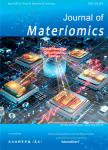Composition dependence of giant electrocaloric effect in PbxSr1-xTiO_(3) ceramics for energy-related applications
作者机构:School of Physics and Optoelectric EngineeringGuangdong University of TechnologyGuangzhou Higher Education Mega CentreGuangzhou510006China School of Materials and EnergyGuangdong University of TechnologyGuangzhou Higher Education Mega CentreGuangzhou510006China
出 版 物:《Journal of Materiomics》 (无机材料学学报(英文))
年 卷 期:2019年第5卷第1期
页 面:118-126页
核心收录:
学科分类:081702[工学-化学工艺] 08[工学] 0817[工学-化学工程与技术]
基 金:the National Natural Science Foundation of China(Grant Nos.11574057 and 51604087) the Guangdong Provincial Natural Science Foundation of China(Grant No.2016A030313718) the Science and Technology Program of Guangdong Province of China(Grant Nos.2016A010104018,and 2017A010104022)
主 题:Pb_(x)Sr_(1-x)TiO_(3)ceramics Electrocaloric effect Phase transition Energy applications
摘 要:Pb_(x)Sr_(1-x)TiO_(3)(x=0.30,0.35,0.40,0.45,0.50 and 0.55)ceramics were fabricated by a solid-state reaction *** diffraction data at room temperature show PST samples shift from cubic to tetragonal phase with the increase of Pb^(2+) *** microstructures were observed by scanning electron *** measurement was employed to investigate the ferroelectriceparaelectric phase transition *** dependent polarizationeelectric field hysteresis loops were conducted to study the electrocaloric effect(ECE)of the ferroelectric ceramics by indirect methods over a wide temperature *** measurement of temperature change(DT)at room temperature for all samples can achieve 0.79e1.86 *** s more,a giant ECE(△T=2.05 K,EC strength(△T/△E)=0.51×10^(-6) K m/V,under 40 kV/cm)was obtained in the sample of x=0.35 near phase transition *** results suggest that the ceramics are promising cooling materials with excellent EC properties for energy related applications.




